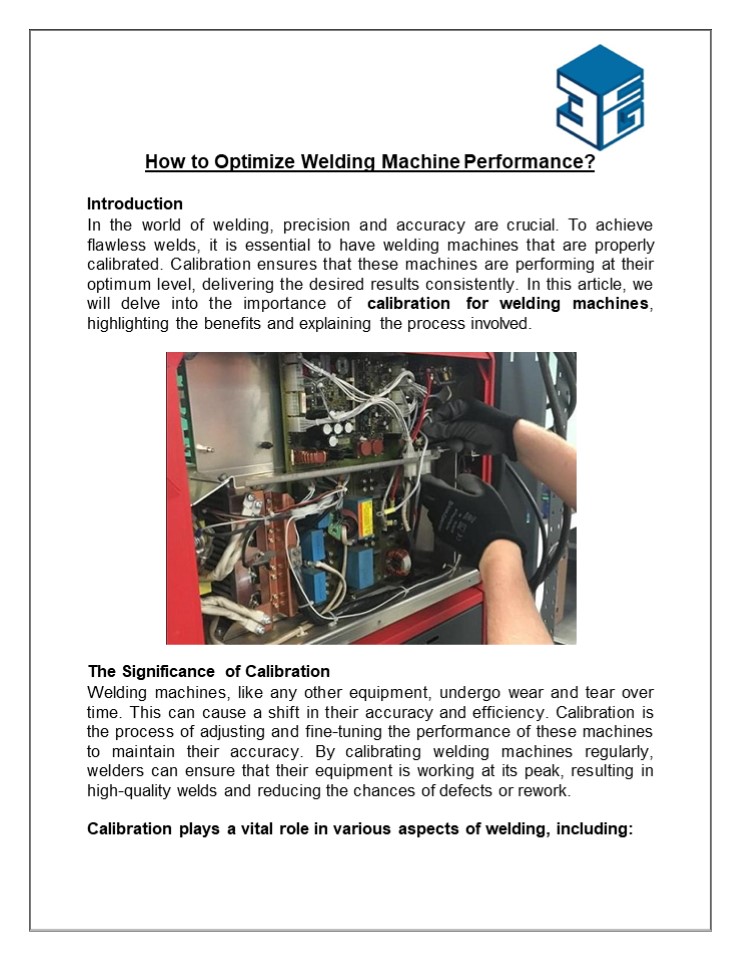How to Optimize Welding Machine Performance? - PowerPoint PPT Presentation
Title:
How to Optimize Welding Machine Performance?
Description:
Calibration of welding machines is a critical step in ensuring precise and consistent welds. By calibrating regularly, welders can maintain the accuracy and efficiency of their equipment. This leads to improved weld quality, compliance with industry standards, increased efficiency, and a longer lifespan for the machines. – PowerPoint PPT presentation
Number of Views:0
Title: How to Optimize Welding Machine Performance?
1
How to Optimize Welding Machine
Performance? Introduction In the world of
welding, precision and accuracy are crucial. To
achieve flawless welds, it is essential to have
welding machines that are properly calibrated.
Calibration ensures that these machines are
performing at their optimum level, delivering the
desired results consistently. In this article, we
will delve into the importance of calibration
for welding machines, highlighting the benefits
and explaining the process involved.
The Significance of Calibration Welding machines,
like any other equipment, undergo wear and tear
over time. This can cause a shift in their
accuracy and efficiency. Calibration is the
process of adjusting and fine-tuning the
performance of these machines to maintain their
accuracy. By calibrating welding machines
regularly, welders can ensure that their
equipment is working at its peak, resulting in
high-quality welds and reducing the chances of
defects or rework. Calibration plays a vital role
in various aspects of welding, including
2
1. Consistency in Weld Quality A well-calibrated
welding machine ensures consistent weld
quality. Variations in heat output, arc
stability, and wire feed can lead to irregular
welds, compromising the integrity of the joint.
Calibration minimizes these variations, providing
welders with the confidence that their welds will
meet the required specifications every time.
- Compliance with Industry Standards
- Industries have specific quality standards and
regulations that welding processes must adhere
to. Calibration helps welding machines meet these
standards. By ensuring accurate heat, voltage,
and wire feed settings, calibration allows
welders to produce welds that meet
industry-specific requirements, guaranteeing
compliance and safety. - Maximizing Efficiency
- Calibrated welding machines operate with higher
efficiency. By maintaining accurate settings,
the machines consume the appropriate amount
of energy and resources, optimizing productivity.
This efficiency leads to cost
3
savings, as it reduces material waste, decreases
downtime, and minimizes rework. 4. Extended
Equipment Lifespan Welding machines are
significant investments for any welder or
fabrication shop. Regular calibration helps
prolong the lifespan of these machines. By
keeping the equipment in optimal condition,
calibration reduces the chances of premature
failure, minimizing repair costs, and increasing
overall equipment longevity.
The Calibration Process The calibration process
for welding machines involves several steps to
ensure accurate adjustment of key parameters.
Here are the general steps to calibrate a welding
machine 1. Assessing Machine Performance Before
calibration, it is essential to assess the
current performance of the welding machine. This
includes evaluating its accuracy, consistency,
and overall functionality. By identifying any
existing issues, welders can address them during
the calibration process.
4
- Gathering Calibration Equipment
- To calibrate a welding machine accurately,
specific calibration equipment is necessary. This
includes devices such as digital meters,
temperature sensors, and calibration standards.
These tools help measure and adjust critical
parameters like voltage, heat, and wire feed
speed. - Adjustment and Fine-Tuning
- Once the calibration equipment is ready,
adjustments and fine-tuning can be made. This
involves comparing the machine's output to the
desired values using the calibration equipment.
Adjustments are then made to align the machine's
performance with the desired settings. This step
ensures accurate and reliable welds. - Verification and Documentation
- After the adjustments, verification, and
documentation are crucial. Verifying the
calibration through test welds and inspections
helps ensure that the machine is working within
the desired parameters. Documentation of the
calibration process is important for
record-keeping, traceability, and the maintenance
of quality management systems. - Conclusion
- Calibration of welding machines is a critical
step in ensuring precise and consistent welds.
By calibrating regularly, welders can
maintain the accuracy and efficiency of their
equipment. This leads to improved weld quality,
compliance with industry standards, increased
efficiency, and a longer lifespan for the
machines. Investing time and effort into
the calibration process is not only beneficial
but essential for welders aiming for top-notch
performance in their welding operations. So,
don't overlook the importance of calibrationyour
welds deserve it. - To Know More Visit https//thirdcoastgage.com/cal
ibration- services/physical-capabilities/































